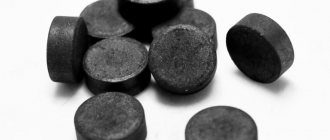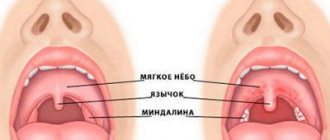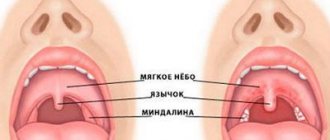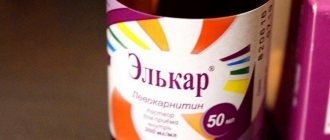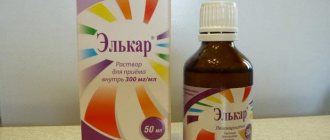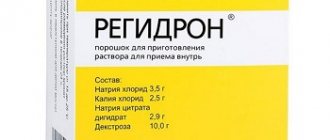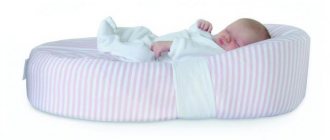pharmachologic effect
The therapeutic effect of Berodual is explained by two active components. The first component, ipratropium bromide, is an m-anticholinergic drug that blocks the neurotransmitter acetylcholine and inhibits reflexes caused by the vagus nerve. The second active component fenoterol belongs to beta-2-adrenergic agonists.
Both substances enhance the effect of each other and relax the smooth muscles of the bronchi.
After using the medication, bronchospasm disappears within 15 minutes (narrowing of the lumen of the bronchi and bronchioles, which causes suffocation) and lung function improves. The maximum therapeutic effect of the drug is achieved 1 or 2 hours after inhalation of the drug. The effect of the medication lasts up to 6 hours.
The drug does not have a negative effect on the formation of mucus in the bronchi and on gas exchange in the lungs.
It prevents the development of bronchospasm due to allergies.
The medication has proven its effectiveness in clinical trials.
Instructions for use
The doctor must select the dosage schedule for each child individually. During therapy, the following should be considered:
- Inhalations with Berodual solution should be done under the supervision of a healthcare professional. They can be done at home only with the permission of a doctor, when the use of a fast-acting β-agonist in low dosages is ineffective. It can be used when an aerosol cannot be used or the drug is needed in high dosages.
- Treatment with the drug should be started with the minimum effective dosage and interrupted when the patient’s well-being improves.
- 1 ml of medication contains 20 drops of solution for inhalation.
- Before inhalation, Berodual solution must be dissolved in saline solution so that the final volume of liquid is 3-4 ml, which must be used completely in 1 inhalation. Diluted medication cannot be stored.
- Any modern nebulizer can be used for inhalation.
- If shortness of breath increases while using the drug, you should immediately seek medical help.
- You cannot increase the dosage of the medication on your own, as this may cause progression of the disease or overdose.
- To prevent the drug solution from getting into the eyes during inhalation, the mask that comes with the nebulizer must fit tightly to the face. This is especially important in patients with a predisposition to glaucoma.
- In children with cystic fibrosis, gastrointestinal motility may be impaired during therapy.
- If treatment with the drug causes problems with your eyes, you should urgently consult an ophthalmologist. If glaucoma develops, you may need to use eye drops that reduce intraocular pressure.
- If you experience heart pain during therapy, you should inform your doctor.
- To ensure that the solution does not lose its therapeutic effect, it must be stored at temperatures up to 30 degrees for 5 years from the date of release. It cannot be frozen. To ensure that the aerosol does not lose its effect, it must be stored at a maximum temperature of 25 degrees for 36 months from the date of production. The aerosol can cannot be heated to 50 degrees and disassembled.
- The use of anticholinergic and β-adrenergic medications in combination with Berodual causes even greater dilatation of the bronchi. But this combination increases the likelihood of side effects.
- The therapeutic effect of Berodual is weakened by β-blockers.
- When prescribed during therapy with diuretics and glucocorticoids, the risk of a decrease in potassium in the blood increases, and this can cause heart rhythm disturbances.
Instructions for use of the solution
To relieve an acute attack of bronchospasm, inhalations with Berodual solution should be done in the following dosages:
| Age | Dosages |
| Under 6 years old and weighing less than 22 kg | The dosage for 1 inhalation is 0.1 ml (2 drops) per kg of weight, but not more than 0.5 ml of solution. |
| From 6 to 12 years | A single dosage, depending on the severity of the attack, can be 0.5-2 ml of solution. |
| From 12 years old | Depending on the severity of the attack, the dosage can be 1-2.5 ml of solution. In severe cases, the single dosage can be increased to 4 ml. |
The frequency of inhalations per day and the duration of therapy are determined by the doctor individually.
Instructions for using the aerosol
To relieve an attack of bronchospasm, children over 6 years of age need to spray 2 inhalation doses. If after 5 minutes the child’s well-being has not improved, then 2 inhalation dosages of the medication can be added. If there is no effect after 4 inhalations, you should immediately go to the hospital.
When the medication is prescribed for intermittent and long-term therapy, a single dosage may be 1-2 inhalations. You can do up to 8 inhalations per day.
When spraying an aerosol, the following recommendations must be observed:
- If the medicine canister is used for the first time, you need to remove the protective cap and press twice on its bottom.
- Before the next use, you need to shake the can of medicine.
- Before inhalation, you need to remove the protective cap and turn the can upside down. The child should exhale slowly and wrap his lips around the mouthpiece. After this, you need to press the bottom of the can so that 1 dose is sprayed. During inhalation, the child should hold his breath for a few seconds, then remove the mouthpiece from his mouth and then exhale slowly. To receive the second inhalation dosage, you need to repeat all the steps again.
- After inhalation, you must put on a protective cap.
- When the drug has not been sprayed for more than 3 days, before using the can you need to press its bottom once so that a cloud of medication appears.
- Each container contains 200 doses; after they are used, there may be some liquid left in the container, but it should still be thrown away.
- To check whether there is any amount of medicine left in the can, shake it.
- To prevent the mouthpiece from becoming clogged with drug residues, it should be regularly washed with warm water and air dried.
Instructions for safe use
Berodual is used exclusively for inhalation using a special device - a compressor inhaler, or nebulizer. Use in steam inhalers is prohibited.
Unlike many other inhalations, procedures with Berodual can, and in some cases even should, be carried out at night, a few hours before you put the child to bed.
Self-prescription of the drug and its dosage for children are prohibited. The dosage of the drug and treatment regimen are prescribed by the pediatrician based on the diagnosis, age group of the patient and his individual characteristics . For children under 6 years of age, Berodual is used only in the form of a solution and strictly under the supervision of a doctor, as it can cause complex side effects.
Remember that a child should not be inhaled with a nebulizer if he has a fever.
Overdose
These conditions can develop both due to the hypersensitivity of the child’s body to the components of the drug, and due to non-compliance with recommendations for taking the drug. Such irresponsibility can lead to harmful consequences and aggravation of the patient's condition. Overdose symptoms:
- increased heart rate;
- anginal pain (pressing or burning pain in the chest, with a feeling of heaviness and shortness of breath);
- flushes of blood to the face,
- tachycardia;
- heartbeat;
- arrhythmia;
- tremor;
- arterial hypertension or hypotension.
Contraindications and composition
Berodual should not be prescribed to children, regardless of the form of release, if they have been diagnosed with the following pathologies:
- increased heart rate;
- hypertrophic obstructive cardiomyopathy (thickening of the wall of the left or right ventricle of the heart);
- intolerance to the composition of the drug and other atropine-like drugs.
In addition to the active substances ipratropium bromide and fenoterol hydrobromide, the inhalation solution contains additional components such as:
- trilon B;
- benzalkonium chloride;
- sodium chloride;
- hydrochloric acid;
- water.
The aerosol contains such inactive ingredients as:
- ethanol;
- tetrafluoroethane;
- water;
- E-330.
Treatment with medication should be carried out with caution in children with the following pathologies:
- diabetes;
- high blood pressure;
- angle-closure glaucoma;
- hyperfunction of the thyroid gland;
- cardiovascular diseases;
- cystic fibrosis;
- pheochromocytoma;
- obstruction of the bladder neck.
Side effects
Berodual in children can cause a number of undesirable reactions, such as:
- allergy;
- headaches, dizziness, trembling of individual parts of the body, nervousness, mental disorders, excitability;
- cough, pharyngitis, hoarseness, dry mouth, narrowing of the bronchial lumen, irritation, dryness and swelling of the pharynx, sudden contraction of the laryngeal muscles;
- nausea, vomiting, inflammation of the tongue, stomatitis, upset stomach, stool retention;
- increased heart rate, increased blood pressure, cardiac arrhythmia, myocardial ischemia;
- dilation of the pupils, increased intraocular pressure, spasm of accommodation, fog before the eyes, swelling of the cornea, redness of the conjunctiva, pain in the eyes, the appearance of a halo around things;
- decreased potassium content in the body;
- swelling of the oral cavity;
- increased sweating;
- weakness and muscle spasms, muscle pain;
- urinary retention.
If therapeutic doses are exceeded, signs of an overdose of Berodual may appear, such as:
- rise and fall of blood pressure;
- increased heart rate;
- heart rhythm disturbances;
- tides;
- increased narrowing of the lumen of the bronchi;
- an increase in the difference between systolic and diastolic pressure;
- trembling of individual parts of the body;
- angina pectoris;
- chest discomfort;
- dry mouth;
- accommodation disorder.
If symptoms of overdose appear, you should interrupt therapy and immediately seek medical help. In case of drug poisoning, you need to monitor the acid-base balance of the blood. If necessary, the doctor may prescribe sedatives and tranquilizers. β-adrenergic blockers can be used as an antidote, preferably selective ones that preferentially act on β1-adrenergic receptors.
But it must be borne in mind that in asthmatics and children suffering from COPD, their use can cause increased bronchial obstruction, which will lead to the death of the patient.
conclusions
The use of Berodual in inhalation through a nebulizer to relieve acute manifestations of broncho-obstructive syndrome in children of the first year of life against the background of ARVI is effective, it allows you to restore the patency of the bronchial tree on the first day, which contributes to a more rapid restoration of oxygen saturation in the blood.
Considering the effectiveness, as well as the safety of the non-invasive method of delivering the drug to the body and the short duration of use, it is possible to recommend Berodual solution in inhalation through a nebulizer as an emergency bronchodilator for children of the first year of life with broncho-obstructive syndrome.
What to choose Pulmicort or Berodual for a child?
Pulmicort contains budesonide as an active ingredient. This drug belongs to glucocorticoids. It stops the inflammatory process in the bronchi, reduces the severity of bronchial asthma, and reduces the frequency of attacks. With the use of the drug, swelling of the bronchial mucosa, mucus production and excessive activity of the respiratory tract are reduced. Pulmicort is recommended for children older than six months with bronchial asthma, which requires treatment with hormonal drugs. In addition, the drug is prescribed for false croup and COPD.
Pulmicort has proven its effectiveness in clinical trials, but it does not have the same composition as Berodual, it has a different effect. Therefore, it is incorrect to compare these drugs. Only the doctor should decide which remedy is better.
If necessary, he can prescribe them in combination, but you cannot mix both solutions.
Materials and methods
Under our supervision there were 60 children aged from 1 month to 1 year who were treated in the early childhood department of the city children's clinical hospital in Poltava with a diagnosis of ARVI complicated by biofeedback. The diagnosis was made on the basis of clinical examination methods, taking into account the medical history and allergy history. Against the background of standard therapy, 30 children received Berodual inhalations through a nebulizer (1 drop per 1 kg of body weight up to 3 times a day); they made up the main group. 30 children received only standard therapy (mucolytics, anti-inflammatory and antiviral drugs, selective b2-agonists). These children formed the control group. All children were admitted to the department in a state of moderate severity. 12 (40%) children in the main group had a history of atopic dermatitis; in the control group, this pathology was observed in 4 children (13.3%). Anemia of the 1st degree was noted in 6 (20%) children in the main group and in 4 (13.3%) in the control group.
Lazolvan or Berodual?
Lazolvan belongs to the group of mucolytics. The therapeutic effect of it is explained by ambroxol, which confirmed its effectiveness during clinical trials. The drug is recommended for wet coughs with the formation of thick sputum to facilitate its removal from the body.
It is incorrect to compare Lazolvan and Berodual, since they have different active ingredients, indications, contraindications and side effects.
If necessary, the doctor can prescribe these medications in combination.
Salbutamol or Berodual?
Salbutamol is produced by a number of domestic and foreign companies in the form of an aerosol or solution for inhalation. The drug belongs to the selective β-2-adrenergic agonists, which relaxes the smooth muscles of the bronchi and eliminates bronchospasm. It has confirmed its effectiveness in clinical trials.
Salbutamol has the same indications for use as Berodual, but they have different contraindications and adverse reactions, so only a doctor should decide which medication is better.
Reviews
Parents' opinion
Parents mostly leave positive reviews about Berodual. They note that after inhaling the drug, the effect comes quickly. They also like that the medicine is used in the form of inhalations and there is no need to force the child to take the medicine.
Negative reviews are due to the fact that an allergy to Berodual is possible, as well as a number of other side effects.
Doctor Komarovsky's opinion
Evgeniy Olegovich has a good attitude towards inhalations, but they should only be done on the recommendation of a doctor. Also, only a doctor should prescribe medications that can stop bronchospasm attacks.
Berodual belongs to the list of prescription drugs, so self-medication is prohibited. Only the doctor should decide how to use Berodual in children.
By
Results and its discussion
When analyzing the clinical manifestations of BOS in the children we observed, a significant reduction in their duration was noted (Fig. 1).
Thus, a non-productive, dry, paroxysmal cough in children of the main group was observed for 3 days versus 5 in children of the control group. Shortness of breath up to 60–70 breaths per minute with the participation of auxiliary muscles in the main group disappeared within the first day, in the control group - within 3 days. On the very first day, in children who received Berodual therapy through a nebulizer, wheezing “distant” wheezing disappeared, while in children in the control group they were observed until the 4th day of therapy. On auscultation, wheezing was heard in the children of the main group for 3 days versus 5 in the control group. The longest-lasting manifestations of intoxication were (pallor, loss of appetite, lethargy, moodiness), which is explained by the negative influence of viral aggression, which did not depend on the duration of biofeedback.
At the same time, all children underwent dynamic determination of oxygen saturation in the blood using pulse oximetry. An increase in oxygen saturation to 96–98% in children in the main group was noted on the second day; in children in the control group, an improvement in oxygen saturation was noted only on the 3rd day.
